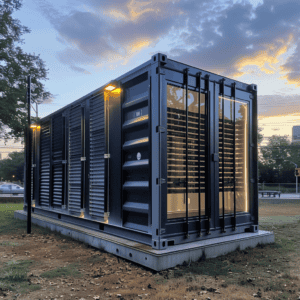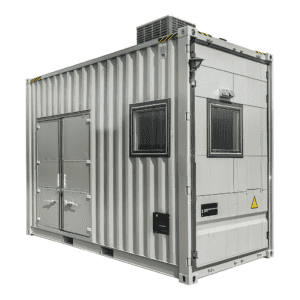You might think, ‘It’s just a shipping container, why bother about ventilation?’ But, you’d be surprised how crucial proper ventilation can be.
It’s not just about preventing condensation and rust. It’s about protecting your stored items from damage and ensuring a healthy environment if you’re converting it into living or working space.
So, let’s dive into understanding how you can effectively ventilate your shipping container. It’s simpler than you’d imagine!
Brief Overview of the Importance of Ventilating Shipping Containers
To ventilate a shipping container, install passive vents or an active ventilation system on opposite ends to ensure cross-flow air circulation and reduce condensation.
Regularly ventilating your shipping container is crucial to prevent the buildup of condensation, which can lead to serious damage to your stored goods. You’ll need a proper ventilation system that includes air vents for sufficient air circulation. Shipping container vents help maintain temperature control, decreasing both moisture buildup and humidity levels inside the container.
But why is it so important to ventilate a shipping container? Well, improper ventilation can result in a damp interior, promoting the growth of mold and mildew, potentially ruining your items. In essence, shipping container ventilation is a vital step in ensuring the longevity of your goods and the container itself.

Understanding Ventilated Shipping Containers
Now that you’re aware of why ventilating your shipping container is crucial, let’s delve into understanding more about ventilated shipping containers themselves.
A ventilated shipping container is a result of shipping container modifications that improve air ventilation. This can be achieved by incorporating passive vents or active ventilation systems. Passive vents allow natural air flow, while active systems use mechanical methods to control the temperature inside the container. Both methods increase the air flow, reducing condensation and improving the overall environment inside the container.
The Need for Extra Ventilation
While understanding the types of ventilation systems and container vents is crucial, it’s equally important to recognize when you might need extra ventilation in your shipping container. If your stored items are prone to damage from high humidity, you’ll need additional ventilation to maintain a dry environment.
Even with the small vents that come standard in most containers, adequate ventilation may not be achieved, especially in climates with high humidity. Passive ventilation systems promote minimal airflow, but in some cases, they aren’t enough. You may need to install more vents to ensure proper ventilation.
Assessing your shipping container’s ventilation needs won’t only protect your stored items but also extend the lifespan of the container itself.
Options for Ventilation
In addressing your shipping container’s ventilation needs, you’ve got a variety of options to consider. You can add ventilation in a number of ways to promote airflow inside the container. One common method involves installing vents. These can be placed strategically to allow natural airflow, helping to circulate air effectively.
Another option could be to install a HVAC system, which would provide extra ventilation and control over the temperature and humidity. Louvers can also be added to your shipping containers to increase ventilation and promote natural airflow.
Whichever ventilation options you choose, the goal is to ensure good airflow and prevent any buildup of heat or moisture inside the container. It’s all about finding the right balance for your specific needs.

Installation Guide
Understanding the installation process for your chosen ventilation system is crucial to achieving optimal airflow in your shipping container. This installation guide is here to help.
Start by determining the type of ventilation required. Active vents, such as exhaust fans or mechanical fans, are ideal for climate control in sealed container types. They’ll require a power source but can provide significant airflow.
For passive ventilation, consider adding vents. Decide between smaller vents, which are easy to install but provide limited airflow, and larger vents that allow more air circulation. Remember, placement is key for both active and passive systems to ventilate a shipping container effectively.
Follow manufacturer instructions closely, and ensure your container is ready to weather any storm.
Considering Climate Control
After setting up your container’s ventilation system, it’s time to consider your climate control needs. Depending on the climate changes in your area, high temperatures can cause hot air to be trapped in your storage container.
An effective way to combat this is by installing an air conditioning unit. This won’t only ventilate the shipping container, but also regulate temperature changes, making the environment inside the container much more manageable, especially for sensitive items.
However, it’s essential to remember that air conditioning can generate moisture. Therefore, you should also consider installing a dehumidifier alongside your air conditioning unit, to prevent the buildup of dampness.
Additional Measures for Optimal Ventilation
Beyond just setting up a basic ventilation system, you’ll find it’s important to take additional steps for optimal airflow in your shipping container.
Ensuring constant fresh air intake is crucial. You can achieve this by installing small air vents or special air vents designed for better airflow. These will allow cold air to circulate, maintaining a cool temperature in a shipping container, and create a safe environment for storing items.
Another effective measure is to install a secondary roof. This can significantly reduce heat build-up, promoting minimal airflow inside the container. Remember, the aim isn’t just to ventilate, but also to create an environment conducive for the items you’re storing.
Frequently Asked Questions
What is the best ventilation for a shipping container?
The best ventilation system for a shipping container depends on its intended use, the climate it’s located in, and what is being stored inside. Generally, passive vents are a good starting point for basic airflow needs, allowing air to circulate naturally and prevent the buildup of condensation. For more controlled ventilation, especially in containers used for living spaces or sensitive storage, active ventilation systems such as exhaust fans or HVAC units might be necessary.
These systems can regulate temperature and humidity more effectively, providing a safer environment for both people and stored items. In hot climates or for containers exposed to direct sunlight, installing a whirlybird (turbine vent) can also be effective in removing hot air and reducing the internal temperature. Ultimately, the best ventilation solution may involve a combination of these options to meet the specific needs of the container’s usage.
Do shipping containers need to be vented?
Yes, shipping containers need to be vented to prevent the accumulation of condensation. This can lead to mold growth in shipping containers, but also rust and damage to the contents inside. Ventilation is crucial for maintaining the structural integrity of the container and the safety of its contents, especially in fluctuating temperatures and humid climates.
Even for basic storage, adequate ventilation helps ensure that goods remain in good condition over time. For specialized uses, like habitation or sensitive storage, the need for proper ventilation becomes even more critical to ensure a healthy and safe environment.
How do you add ventilation to a storage container?
Adding ventilation to a storage container involves several steps and options, depending on the specific needs of the container’s use. The most straightforward method is installing passive vents, which can be done by cutting holes in the container’s walls or roof and attaching vents to allow air to flow naturally. These vents should be placed strategically to promote cross-ventilation, typically one on each end of the container.
For more active ventilation, electric fans or exhaust systems can be installed to forcibly circulate air, which is particularly useful in hot climates or for containers housing sensitive materials. Solar-powered vents offer a sustainable option, harnessing solar energy to power fans without the need for an external electricity source. For containers used as offices or living spaces, installing an HVAC system might be necessary to provide both ventilation and temperature control. Regardless of the method chosen, it’s crucial to ensure that the ventilation system is adequately sealed and protected to prevent water ingress and maintain the container’s structural integrity.
Do shipping containers need to be vented?
Yes, shipping containers typically need to be vented, especially when they are repurposed for storage or as living or working spaces. Ventilation is crucial for preventing the buildup of condensation inside the container, which can occur due to temperature fluctuations between the interior and exterior environments.
Without proper ventilation, condensation can lead to rust, mold, and mildew, damaging its contents and hindering shipping container maintenance efforts. Venting helps to regulate the air quality and temperature inside the container, making it safer and more comfortable for use. Additionally, for specific uses such as transporting or storing chemicals, perishable goods, or sensitive equipment, specialized ventilation systems may be required to manage humidity levels and ensure the safety of the contents.
Conclusion
With these measures in place, you’re well on your way to achieving optimal ventilation in your shipping container. Ventilation isn’t just about letting air in, it’s about controlling the heat and humidity levels to create a safe environment for your goods.
Proper ventilation, from the walls to the roof, is key to preventing damage caused by condensation and heat build-up.
Remember, it’s essential to monitor the conditions inside your shipping container regularly. Changes in weather can drastically affect the heat and humidity levels. By taking these steps, you’re ensuring that your shipping container remains a safe, damage-free space.


